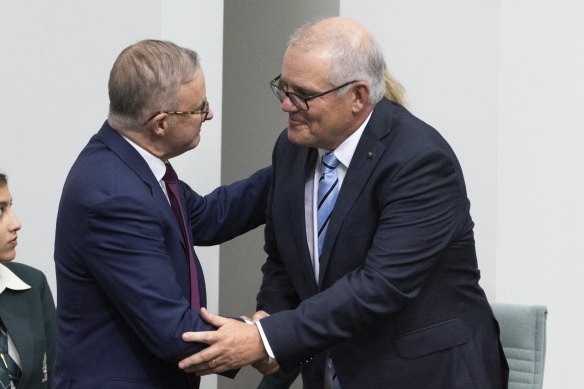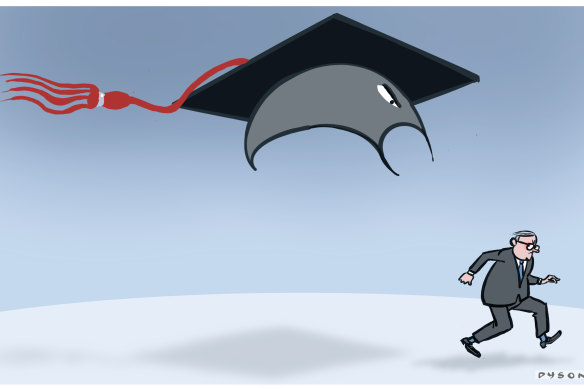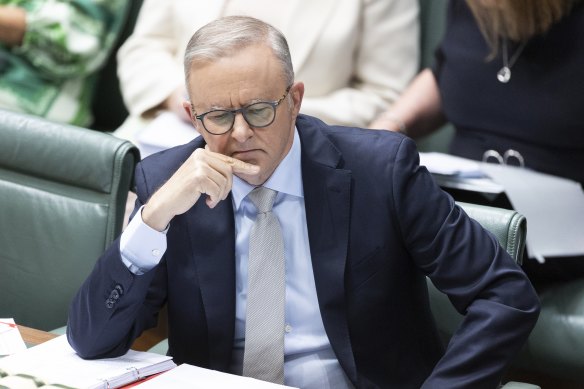This was published 8 months ago
Opinion
Morrison handed Albo a cowpat sandwich. Now it’s time to pay for it
Ross Gittins
Economics EditorIt never pays to be too sorry for politicians. They’re all volunteers, they’re well paid for what they do, and even the nicest of them have thrust themselves ahead of many others to get as far as they have.
But I can’t help feeling a bit sorry for Anthony Albanese. He got himself elected by promising not to change much, but I doubt he expected to be handed quite such a cowpat sandwich from the smirking Scott Morrison.

Scott Morrison and Anthony Albanese exchange a handshake (and a cowpat sandwich). Credit: Alex Ellinghausen
As part of his efforts to prove he could keep taxes lower than Labor, Morrison avoided fixing anything much and allowed waiting lists to build up. Now everywhere Albo and his ministers look, they find problems.
These problems will be expensive to fix. This week it’s Education Minister Jason Clare’s turn in the spotlight. The final report on the Universities Accord, which was released on Sunday, reveals plenty that needs fixing.
For openers, the previous government’s job-ready graduates scheme has been a disaster. Under the guise of encouraging students to pick courses that left them job-ready, it cut fees for teaching and nursing, while more than doubling the fees for such courses as arts and humanities, including economics and law.
As the experts predicted, this had little effect on the courses chosen. But it did have its intended effect: saving the government money. One expert suggests that returning tuition fees to something more reasonable could cost the government about $1 billion a year.
The report recommends that the fees for particular courses be set according to the expected lifetime earnings of someone with that degree. Good idea.
I’ve always been happy to defend the HECS-HELP debt scheme as a way of getting people to contribute towards the cost of their education. With repayments geared to the size of their income, and an interest rate far below commercial levels, it should not deter youngsters from poor families from attempting to better themselves.
But unsympathetic governments have fiddled with the scheme incessantly, and with the (hopefully brief) return to high inflation, it’s not surprising Gen Z is so dissatisfied. But Clare seems disposed towards the tweaks the report proposes.
Annual indexation of the debt would occur after deducting the year’s repayments, rather than before. The debt would be indexed to the lower of the rise in consumer prices or the wage index. And the rates at which repayments were required would be applied to successive slices of your income, just as income tax is applied.

Illustration: Andrew Dyson. Credit:
There are shortages of workers with various tertiary qualifications at the moment, and the report sees the demand continuing to grow. At present, about 60 per cent of workers have trade or degree qualifications, and we need to reach at least 80 per cent by 2050, the report says. This would involve more than doubling the number of Commonwealth-supported students each year to 1.8 million.
Clare worries that not enough disadvantaged young people are making it to – and through – uni. (Let me tell you, people have been worrying about this at least since Gough Whitlam’s day. And even making university free didn’t help much.)
At present, people from poor families – those of “low socio-economic status” in academic-speak – account for about 17 per cent of enrolments, compared with 25 per cent of the population. Other target groups are First Nations peoples, people with a disability and people living in regional and remote areas.
The report proposes that uni students’ places be funded on a needs basis, similar to Gonski’s scheme for schools. Unis would receive a base amount per student, plus further loadings according to the particular students’ disadvantage.
This would mean regional and outer-suburban unis got a lot more funding per student than the sandstone central-city Group of Eight. But the extra money would be used to reduce the chances of disadvantaged students failing to complete their course for monetary or other reasons.
There would be fee-free courses to prepare chosen students for the rigours of university learning, and financial support for students required to undertake presently unpaid work placements.
It all sounds a big improvement. Quite apart from fairness, it’s clear that the higher the proportion of young people the government wants with a uni degree, the more it will need to include people from disadvantaged backgrounds.
But note this: none of these good ideas has been costed, let alone accepted by the Albanese government. We don’t know whether those that are accepted will start in this year’s budget or in 10 years’ time.

I can’t help feeling a bit sorry for Anthony Albanese. Credit: SMH
As for Gonski-like arrangements, the real Gonski needs-based funding for schools has still not been fully implemented more than 12 years later.
Let me quote Clare back at himself: “We’re not going to tackle this problem if we think that we can solve all the problems at the door of the university when someone turns 18.”
Just so. With education, it’s best to start at the bottom and work up. But we won’t solve many of our multitude of problems until some pollie has the courage to say maybe we need taxes to be higher, not lower.
Ross Gittins is the economics editor.
Ross Gittins unpacks the economy in an exclusive subscriber-only newsletter. Sign up to receive it every Tuesday evening.